Merry Christmas!
Sandra Boynton deftly portrays a dog on the night before Christmas.

Sandra Boynton deftly portrays a dog on the night before Christmas.
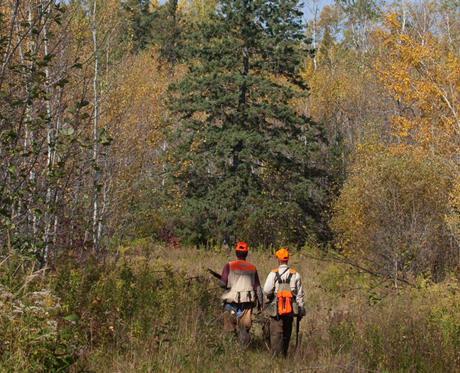
Applying the Paretto Principle, or the 80/20 rule, to grouse hunting: 20% of hunters bag 80% of the birds.
In some recent reading, I came across a reference to the Pareto Principle.
Vilfredo Pareto was an Italian economist who, in 1906, discovered an unequal distribution of land ownership in his country: 80% of the land was owned by 20% of the population.
Later discoveries and studies concurred with Pareto’s simple yet crucial finding and suggested this distribution can be applied to many things. It also gained new names:
• 80/20 rule
• principle of factor sparsity
• law of the vital few and trivial many
So what does this have to do with bird dogs? I see several applications—from breeding and competition to hunting.
Breeding
Not only are 20% of the breeding dogs producing 80% of the outstanding puppies, but I think it applies to dog breeders. In other words, about 20% of the breeders are turning out 80% of the high quality dogs.
Competition
How about dogs competing in field trials? Theoretically, every dog entered has a chance to win but usually only a few are truly likely to win. Too, in any given season, a vital few will win a large share of the competitions.
Hunting
In A Passion for Grouse, John Kubisiak, Wisconsin wildlife researcher, conducted intensive grouse studies on the Sandhill Wildlife Area. His concluded that “about 20 percent of the hunters bagged all the grouse.” That’s probably true. While many hunt grouse, few are successful.
Photo above © Chris Mathan, The Sportsman’s Cabinet.
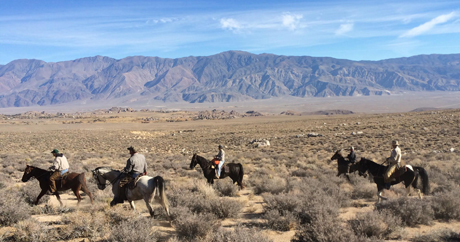
The California Chukar Championship and companion derby stake are held in a valley against the beautiful backdrop of the Alabama Hills.
The differences in field trial venues across the U.S. are amazing. Jerry and I are very familiar with grouse trial grounds, whether aspen cuttings of the Lake States, Pennsylvania’s more open, mature forests or thick cover of the northern New England. Too, we’ve seen trials held on wide open prairies and historic plantations in the South.
But the location of the California Chukar Championsip and Derby in Lone Pine is vastly different.
Lone Pine, California, is in Owens Valley with the Sierra Nevada mountain range to the west and the Alabama Hills to the east. It’s considered high desert (average annual precipitation less than six inches) with an elevation of 3,727 feet.
It’s so stunning that movie producers have used various locations in the area for decades. Actors from movies long ago include John Wayne, Bing Crosby, Humphrey Bogart, Spencer Tracy and Barbara Stanwyck while more current actors are Jeff Bridges, Russell Crowe and Robert Downey, Jr.

Bill Owen moves in to flush for Northwoods Charles in the California Chukar Derby held near Lone Pine, California, in mid November.
That we know about the trial is due to Bill Owen, a Californian and amateur competitor on the all-age circuit, who bought a puppy from us out of Northwoods Chardonnay by CH Ridge Creek Cody in 2012. His brother Steve (from Montana) had bought a puppy from us in 2011 out of Northwoods Blue Ox x Northwoods Chablis and, also in 2012, a CH Houston’s Blackjack x Northwoods Chablis male.
The championship and companion derby, hosted by the Setter Springs Field Trial Club, were held in mid November. Following are the placements.
California Chukar Championship (27 dogs)
• Champion: Utah’s Red Rock Express (pointer male), owned by Herb Anderson, handled by Rich Robertson
• Runner-Up: Highground Jax Jabba (setter male), owned by Chuck and Kara Kunde, handled by Lori Steinshauer
California Chukar Derby (16 dogs)
• 1st Place: Scent Seeker (pointer male), owned and handled by Ed Dixon
• 2nd Place: Tekoa Mountain Bulldog (setter male), owned and handled by Bill Owen
• 3rd Place: Northwoods Charles (setter male), owned and handled by Bill Owen
This isn’t the first time Bill has campaigned Charlie, nor is it the first time the dog has placed. Charlie won the derby held in conjunction with the Cascade All-Age Championship and placed third in the Larry Brech Memorial Open Derby Classic. Bill commented: “He’s coming along really well. Took him chukar hunting after the trial. Had 9 finds in 90 minutes!!!!”
“Yikes!” I thought. “I know that dog.”
I was browsing the magazine section of The Bookshelf, a very nice shop in Thomasville, Georgia, where Jerry and I are living for the winter. On the cover of the December 2014/January 2015 issue of upscale Garden & Gun, was Shadow Oak Bo, sire of one of our 2014 litters.
But Bo is a cover dog because he’s the champion in back-to-back wins of the National Championship (2013-14) and the first setter to do so since 1901-02.
The photograph by Robb Aaron Gordon is a beautiful close-up of Bo from the front. His dark nose and upper body are slightly blurred so the focus becomes Bo’s eyes—brown and fringed with white lashes. To me, those eyes reveal an inner calmness, kindness and sensibility.
The feature section is titled “Best of the Sporting South” and Tom Keer writes a good story about Bo and his triumvirate—Butch Houston and John Dorminy as owners and Robin Gates as trainer and handler.

All eight puppies (here at seven weeks of age) out of Northwoods Chardonnay by CH Shadow Oak Bo are tri-color.
When Paul Hauge, our partner in many ownerships and breedings, bought Northwoods Chardonnay early last summer, Paul and Jerry agreed that Bo would be a great fit for Chardonnay. Using frozen semen, we bred her via surgical implantation and on August 8, she whelped three males and five females. Paul picked two females and we picked two females and all four are with us now in Georgia.
The puppies are barely four months old but we’re impressed so far. They inherited Bo’s calm nature and the light-footed grace of Chardonnay. It will be fun to develop them and interesting to see them mature.
Who knows what we’ll have, but we’re always optimistic. Especially with a sire like Bo.
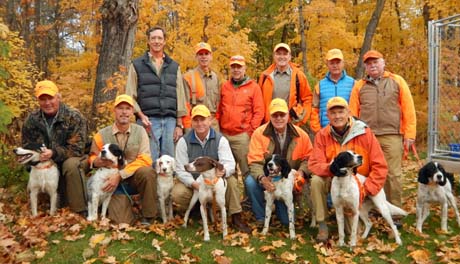
Prior to a day in the woods, grouse hunters, guides and their dogs gather at Bowen Lodge on Lake Winnibigoshish. With the exception of the pointer, all the setters were bred and trained by us.
As expected, ruffed grouse were hard to come by this year in Minnesota. The drumming counts were up last spring but the early-to-mid years of a decade have always been times of fewer grouse. The late spring and wet nesting season did not help as few broods were found. While warm temperatures in October were common state-wide, conditions varied from very dry in the northwest to quite wet in central Minnesota.
Based on personal observation as well as client reports, some areas of the state had higher numbers of birds flushed.
Low grouse numbers usually mean a higher proportion of adult birds encountered. These survivors are the most difficult for both a bird dog to handle and a for hunter to shoot. They run more, flush farther away and when they do flush, they fly low. (Age a bird shot that flushed across a trail and flew straight away and it’s likely to be an immature bird.) The woodcock numbers were again a pleasant surprise and made the spans of time between grouse flushes more exciting.
Besides all that, it was still a great season.
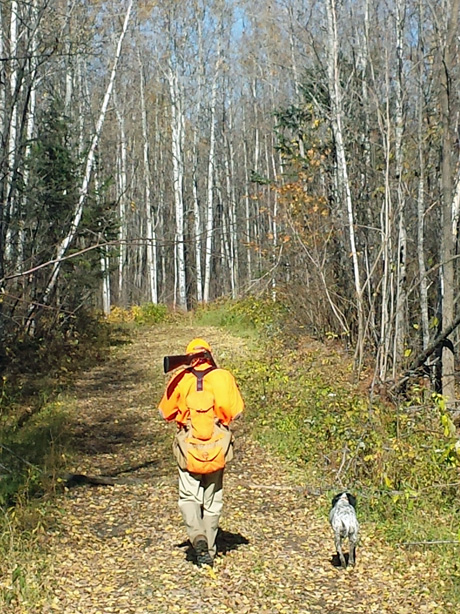
It doesn’t get any better than this. After a successful hunt on a quintessential autumn afternoon, Ken and his setter Roxie walk back along the tote road.
I spend most of October guiding out for Bill and Gail Heig of Bowen Lodge on Lake Winnibigoshish. A special group of hunters have been coming to Bowen for decades and most have become good friends. It’s always fun to see them and share our passion in the woods.
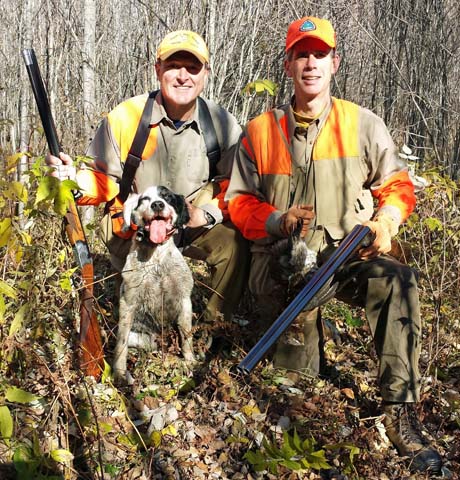
Hunters John and Brian bagged a big male drummer that had been pointed by experienced bird dog Shaq.
Again, as in recent low-cycle years, we all saw how valuable a savvy, experienced grouse dog can be. With their knowledge and experience, they find and point far more birds. Shaq (age 10) and Ox (age 7) perfectly fit that description; Carly and Vixen (both age 3) came into their own by mid-season. Rum Rickey and Slash filled in when needed and did solid jobs.
An exciting surprise was our 18-month-old pointer male, Northwoods Jaguar (Elhew G Force x Northwoods Vixen, 2013). He showed a natural inclination to point and retrieve grouse with very little handling. His composure around game and ability to follow flushed birds and point them again was developed well beyond his young age. Jaguar’s five-month-old half sister, Platinum (Elhew G Force x Northwoods Prancer), also showed her proclivity by pointing grouse and woodcock as well as retrieving/carrying the dead birds around.
All guides and most of the guiding clients at Bowen Lodge have purchased dogs from us over the years. It’s insightful to watch the dogs develop over the years and gratifying to see the bonds between dogs and owners.
Setters include:
• Sunny (Blue Chief x Forest Ridge Jewel, 2003)
• Roxie (CH Terhaar’s Rocko x CH A Rolling Stone, 2005)
• Casey (I’m Houston’s Image x Blue Silk, 2006)
• Cammie and Daisy (Blue Chief x Blue Blossom, 2007)
• Bobbi (Northwoods Blue Ox x Houston’s Belle’s Choice, 2010)
• Tyler (Blue Shaquille x Houston’s Belle’s Choice, 2011)
• Morris (CH Houston’s Blackjack x Chardonnay, 2011)
Pointers include:
• Maggie (Dashaway x Good Going Moxie, 2009)
• Ice (CH Westfall’s Black Ice x Black Bama, 2011)
• Ginger (Elhew G Force x Northwoods Vixen, 2013)
Bill Heig owns Ice (age 4) and she put on clinic after clinic. She proves there are dogs that can pin—freeze in place, not just point—ruffed grouse.
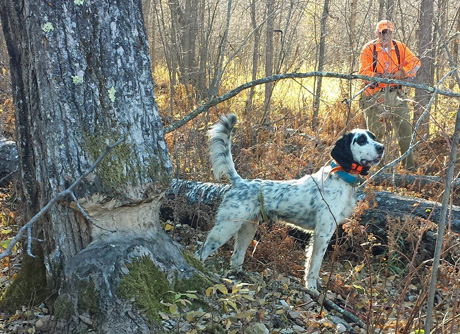
Near the swamp edge at the base of a beaver-chewed maple, Slash has his bird pinned and remains steady as Jim moves in for the shot.
Mike Powers again did a great job working our young dogs. Not only does he know how to put dogs into birds, but he is extremely proficient with a shot gun, too. Low populations can make learning about grouse more difficult and there’s only one way to get that education—keep hunting them.
A big disappointment in our central region was 12” of snow on November 10, followed by bitter cold and strong winds. That put an immediate end to all late-season hunting.
Looking ahead, I’m optimistic that next season there will be more grouse in the woods. But even if there aren’t, I’ll still be out there!
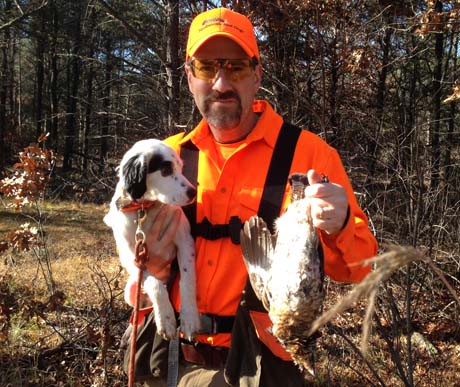
This was the first grouse Ellie (Northwoods Grits x I’m Blue Gert, 2014) pointed. She is a very bold pup, and the check cord you gave us is key to catching her! She is one super little puppy.
~ Tom, Indiana
Autumn is every bird hunter’s favorite season. Judging by the plethora of emails, text messages and photographs Jerry and I received from friends and clients, they spent as much time as possible in the woods and fields with their bird dogs—dogs ranging in age from three-month-old puppies to gray-browed, experienced grouse dogs.
Themes for the season seemed to be:
• lots of birds in the bag
• puppies having a ball and learning lots
• kids with their first grouse
• passionate hunters afield with multiple dogs
• dogs on point in the western U.S.
• dogs on point in the north woods
• suburban dogs yet to get out
• bird dog owners who wish they were better shooters
• lots of happy dogs
Finally, the bittersweet end of the grouse season in the central part of the country was sealed with a blanket of snow.
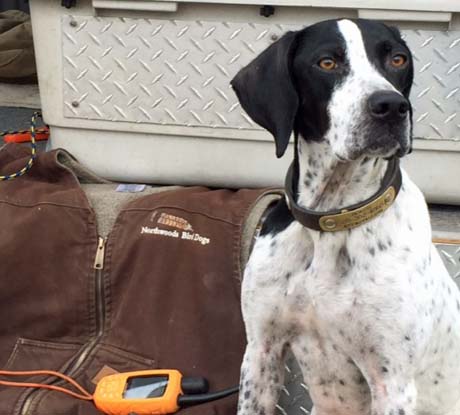
Cool and calm after a grouse hunt in western Wisconsin, CH JTH Izzie (Westfall’s Black Ice x Northwoods Prancer, 2011) is ready to go again as she scans the terrain for more likely spots.
“Oh my God!! There is an aviation term we use for some new guys…..all velocity and no vector! That is Lucy (Shadow Oak Bo x Northwoods Chardonnay, 2014). She is so calm and nice when you stop and pet her…..she just soaks it up…..but take her out side and she is all systems go! And I could not be any happier! Thank you for all your help, and another wonderful dog.”
~ Mike, Minnesota
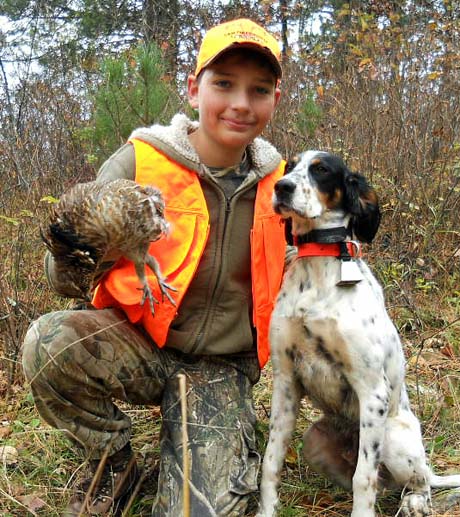
That’s our youngest, Rece, with his first-ever ruffed grouse in central Minnesota. Both he and Finn (Northwoods Blue Ox x Northwoods Chablis, 2014) were elated. So proud of him for a 9-month-old pup! He’s bumping birds frequently but is learning from each encounter. On one bird he locked up 70 yards in front of me and held 5 minutes or more until I busted through a bog to get to him and flush the bird. And then, he won’t even give me time to praise him afterwards – he retrieves and then takes off looking for more! Feeling pretty fortunate to have one of your dogs – especially from Oscar.
~ Todd, Minnesota
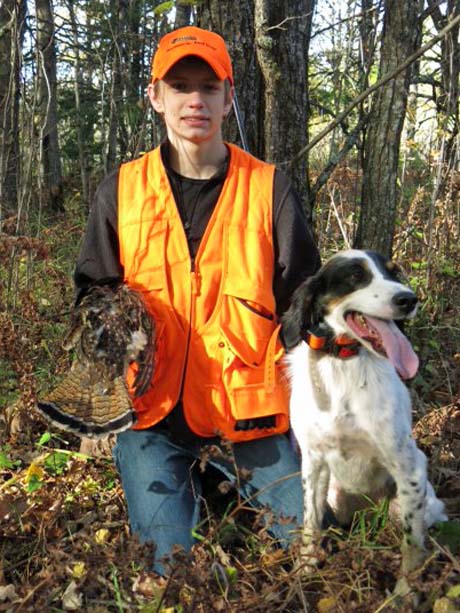
Here is a photo of our youngest son Ryan with his first grouse. It was shot off a beautiful point by Tia (Northwoods Blue Ox x Northwoods Chablis, 2011) a few weeks ago. We’ve been out hunting grouse every weekend. Tia still lives to hunt. Wish I was able to shoot better for her.
~ Ken, Minnesota
“Just wanted you to know that Rose (Blue Riptide x Blue Ghost, 2010) is killing it this year. She is not only a delight at home—but a first-class grouse finder. Chris could not be happier with her and I just overheard him telling her in all earnestness how proud he is to have her as a partner!”
~ Laura, Illinois
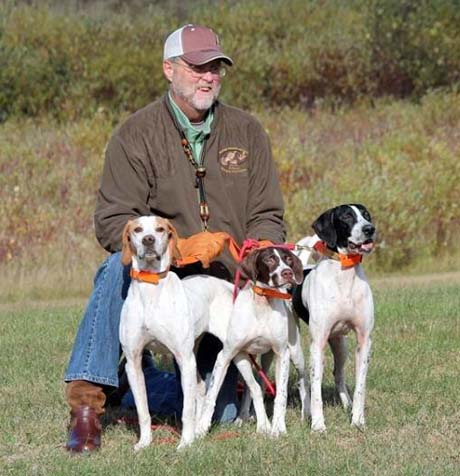
Took the dogs (From left: Prancer (Dashaway x Fallset Fate, 2008), Jordy (Elhew G Force x Northwoods Prancer, 2014), Timber (Westfall’s Black Ice x Nothwoods Prancer, 2011) out on a morning woodcock hunt on Sunday. It was a memorable day. Each dog had some pointed birds and each dog had retrieved birds. Could not ask for anything more.
~ Mark, Wisconsin
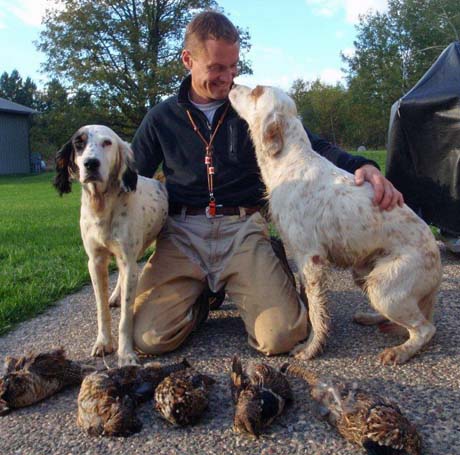
Kate (Houston’s Blackjack x Northwoods Chardonnay, 2010, on left, with Cooper (Blue Chief x Blue Blossom, 2007) was on fire Sunday! For the record, Kate and I had 15 birds in one hour and 30 minutes.
~ Barry, Minnesota
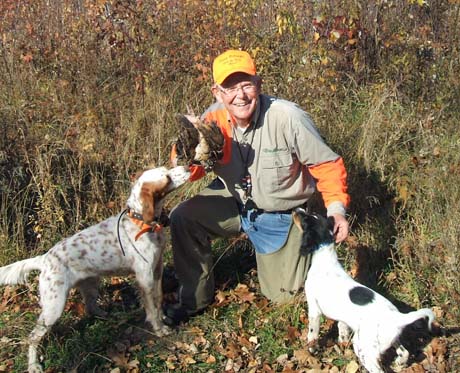
Steve couldn’t be happier after a day in the northern Minnesota grouse woods with his older dog, on left, and Bryn (Blue Riptide x Northwoods Carly Simon, 2014).
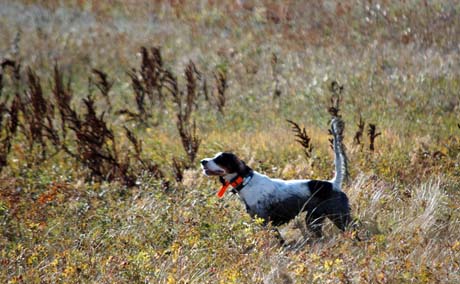
Eastern Montana bird season is in full swing with pheasants opening last weekend. Thank you once again for allowing me the opportunity to own one of your fine bird dogs. I’ve had the pleasure of hunting over a number of dogs in my lifetime. Zada (Ridge Creek Cody x Northwoods Chardonnay, 2013) has drive and intelligence, a rare combination in a young bird dog.
~ Tom, Montana
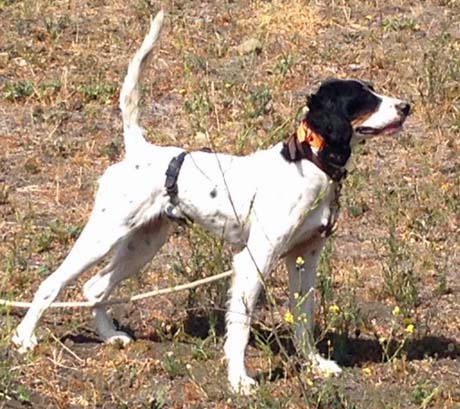
Charlie (Ridge Creek Cody x Northwoods Chardonnay, 2013) has been lighting it up a bit. Was 3rd in the Larry Brech Memorial Open Derby Classic with 18 entries – quite a few from pros. Then won the derby held in conjunction with the the Cascade All-Age Championship. Took him chukkar hunting after trial. Had 9 finds in 90 minutes!!!!
~ Steve, California
“Had a great pheasant hunt with Piper (Ridge Creek Cody x Northwoods Chardonnay, 2013) in South Dakota last week. She was able to pin them pretty tight most of the time. She’s a workaholic who just keeps finding birds and points them beautifully.”
~ Chuck, Minnesota

I thought I would drop you a line to let you know Frisco (Blue Riptide x Northwoods Carly Simon, 2014) is loving her new job…hunting. She naturally loves retrieving and the size of a pheasant is no problem. Other hunters are very pleased as well as us with her disposition; she is so pleasant and well mannered. Frisco listens well and doesn’t go hunting off on her own. She also gets along with other hunters’ dogs.
~ Rick, Minnesota
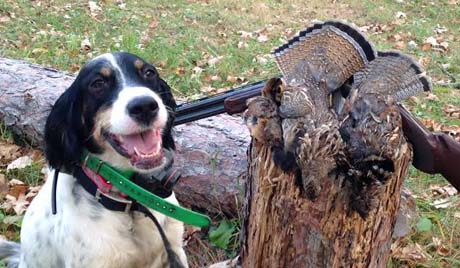
Tired-but-happy Mac (Blue Shaquille x Houston’s Belle’s Choice, 2013) poses with two beautiful ruffed grouse after a hunt in Minnesota.
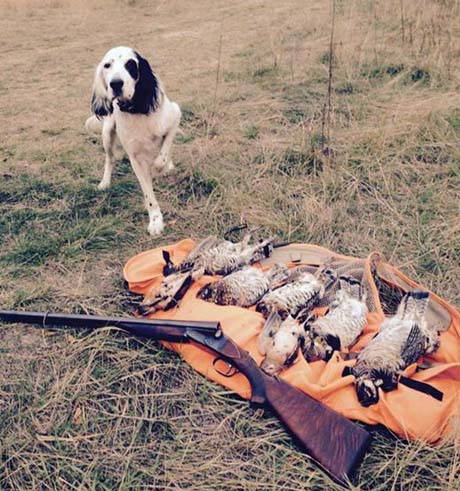
Experience counts. At the age of nine, Jake (Gusty Blue x CH Houston’s Belle, 2005) proudly stands over his birds after hunting in Minnesota.
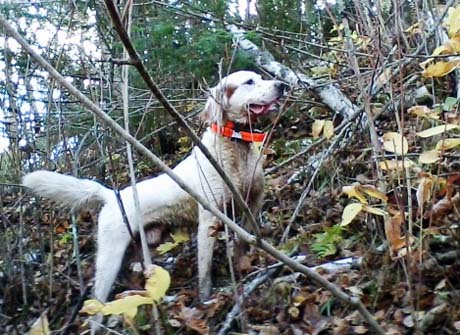
It’s hard to believe Boomer (I’m Houston’s Image x Blue Silk, 2006) is already eight years old. He is still running like a five-year-old, and lots of hunt still in him! Boomer has been a great dog, and I’m hoping his good health will last a few more years.
~ Scott, Minnesota
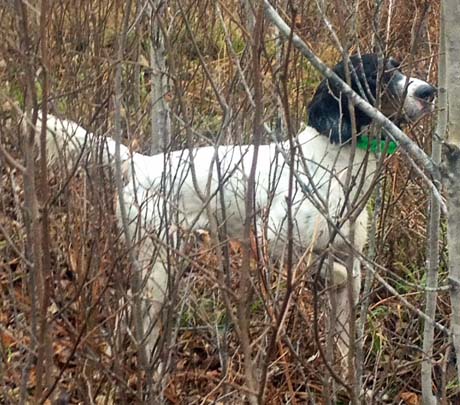
Duke (Blue Shaquille x Houston’s Belle’s Choice, 2013) has had a fantastic season with several points, but this one tonight on a woodcock is about as “classic” as they get! He pointed 19 woodcock this evening and a ruff. At this point in the season he has pointed sharptails, huns, ruffs, woodcock, and pheasants; and he’s backed on all of these as well as sage grouse! Still looks at me when I miss though…
~ Tom, Minnesota
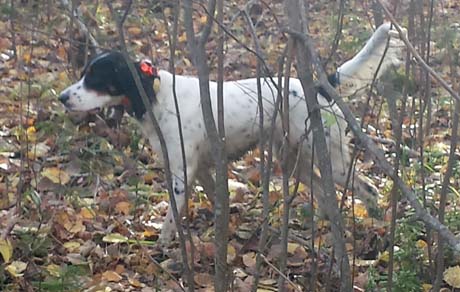
In our one-hour hunt, we had 4 grouse contacts, 2 points, 1 bagged; 17 woodcock contacts, 8 points, 1 bagged. Tana (Northwoods Blue Ox x Northwoods Chablis, 2012) pointed and held steady for her first woodcock, but it flushed wild before I could get to her and she was off to the races. Her points were as intense as I’ve seen from her.
~ Brad, Minnesota
“…Bates (Northwoods Grits x Houston’s Belle’s Choice, 2014) is doing well. He has been running in the woods 4 times a week off leash, and becoming a nice family dog. Thanks for the great dogs.”
~ Jeff, Minnesota
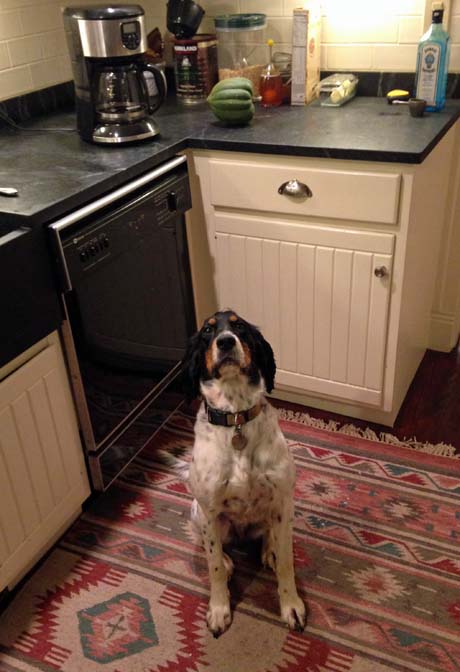
Whatever you two did, you did it right. Rae (Ridge Creek Cody x Northwoods Chardonnay, 2013) has acclimated to suburban life seamlessly. Not one house accident, trained quickly to the electric yard fence, obeys, very trainable to further commands. She is my constant companion and she is the most stylish dog at the dog park. She and I are the best of pals.
~ David, Minnesota
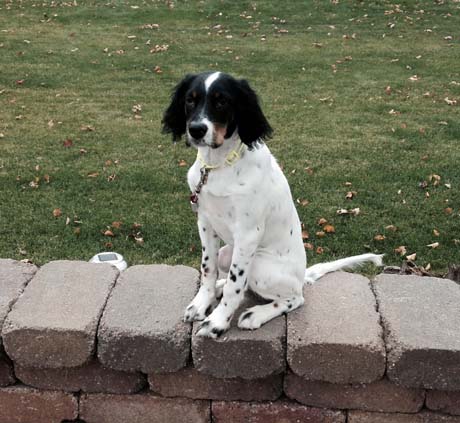
Belle (Blue Riptide x Northwoods Carly Simon, 2014) is getting so big and is always the center of attention. She apparently likes to pose.
~ Robby, Minnesota
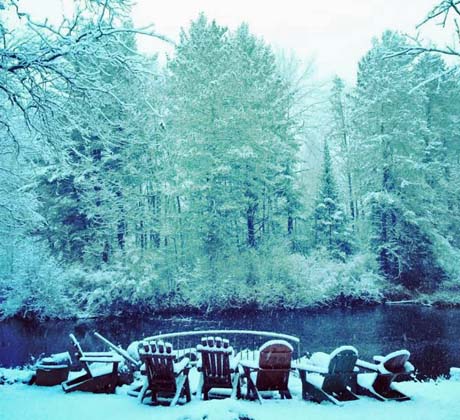
It was truly a magical weekend as the weather cooperated and the birds were abundant! Like the birds at my feeder, the grouse knew the weather was making a major turn for the worse and were busy feeding on the ground. We did have a blanket of snow Sunday morning, but it was actually warmer than the previous days and made for a wonderfully peaceful hunt before we all departed.
~ Chris, Wisconsin

Nick Larson, on left, and his hunting partner Garrett Mikrut, on right, were joined for a day of grouse hunting by Sam Cook, center, Outdoors writer for the Duluth New Tribune, who also reported on the hunt. Photo by northwoodsr.com.
What a cool idea. Nick Larson and his friend, Garrett Mikrut, recently completed a grouse hunter’s dream—seven days pursuing ruffed grouse across its northern Minnesota range. They traveled from Duluth, Two Harbors and Ely to Hackensack. Completing the hunting party were two German shorthairs owned by Mikrut and a 4½-month-old English setter puppy, Hartley, owned by Nick and his wife, Lacey MacLean.
Sam Cook, Outdoors writer for the Duluth News Tribune, reported on their trip in the November 2 edition.
http://www.duluthnewstribune.com/content/duo-spends-week-road-northland-looking-ruffed-grouse
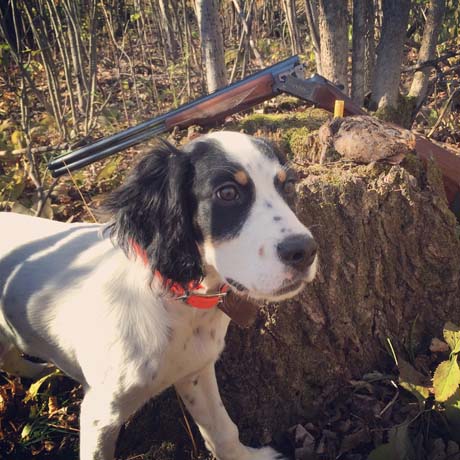
Thanks to Nick Larson’s passion and dedication, his English setter puppy Hartley has gained invaluable experience in the woods this fall. Photo by northwoodsr.com.
Hartley is out of our Northwoods Grits x Houston’s Belle’s Choice litter, which is how Jerry and I met Nick and Lacey. Whether through breeding, training or guiding, we come across many, many people interested in bird dogs and bird hunting but those as passionate as Nick are rare.
In addition to their exploits in the field together, Nick and Garrett maintain a lively blog, Northwoods’R, with beautiful photographs and posts about hunting, fishing and dogs.
http://www.northwoodsr.com/
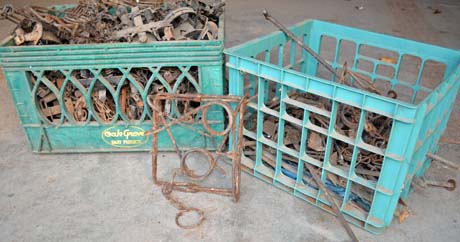
We still store the traps Jerry used when he was young. The collection includes snare, leg-hold and Conibear traps as well as the necessary chains and stakes. The large trap in front is the 220 Conibear that caught Jerry’s Brittany spaniel in 1985.
Jerry will never forget the day in 1985 when he saved the life of his first bird dog, a female Brittany spaniel. While pheasant hunting in the river bottoms of southern Minnesota, he heard a brief, odd, exhaling yelp and then nothing. The sight was horrific. His dog’s neck was caught in the jaws of a 220 Conibear trap.
After a moment of panic and a good kick of adrenaline, he worked quickly, cursing a broken safety catch on one side, and pried the trap open. She was free but not breathing and her gums and tongue had turned blue. Jerry performed mouth-to-mouth resuscitation as the final step.
Fortunately for the dog, Jerry knew about traps and CPR.
From the ages of 11 to 18 years of age, Jerry was a trapper. He used Conibear (although never as large as a 220), snare and leg hold traps, matching trap to quarry—whether fox, raccoon, mink, beaver or muskrat. As required by law, he walked his trap lines every day during the season with a wicker pack basket on his back and gained valuable knowledge about the intricate workings of many kinds and sizes of traps.
Even though Jerry and I haven’t known of any dogs—either ours or dogs owned by friends and clients—killed in traps, we do know of some who were injured. But dogs do die as Doug Smith, outdoor writer for the Twin Cities-based Star Tribune, reported in a piece on January 15, 2013.
http://www.startribune.com/sports/outdoors/187053051.html
We think it behooves all hunters to become familiar with the types of traps they might encounter and how to free a trapped animal.
Snare Trap
Cut the wire (Carry a Leatherman or other tool capable of cutting wire.)
Leg-hold Trap
Step on the spring(s) and the trap will release.
Conibear, also called Body Grip Trap
Print the instructions from the website below and carry with you, along with heavy-duty zip ties as specified at the bottom of the document.
http://www.mntrappers.org/_fileCabinet//bodygrip.pdf
Another life-saving technique that worked for Jerry and his Brittany spaniel is CPR. In addition to resuscitating a dog from a trap, CPR can be useful in other emergency situations.
http://depts.washington.edu/learncpr/cat_dog.html
Many thanks to Chris Bye for the idea of this post.